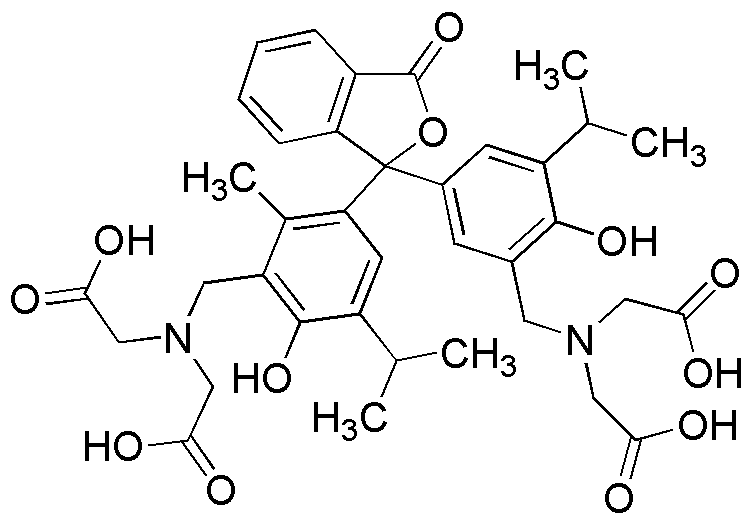Thymolphthalein complexone is widely utilized in research focused on:
- Analytical Chemistry: This compound serves as a pH indicator in titrations, allowing researchers to determine the acidity or alkalinity of solutions with precision.
- Metal Ion Detection: It is effective in chelating metal ions, making it useful in environmental monitoring for detecting heavy metals in water samples.
- Biomedical Research: Thymolphthalein complexone is employed in various assays to study enzyme activities and interactions, providing insights into biochemical pathways.
- Pharmaceutical Applications: It is used in drug formulation processes to enhance the solubility of certain compounds, improving their bioavailability in therapeutic applications.
- Education and Training: This compound is a valuable tool in educational laboratories for teaching students about acid-base chemistry and complexation reactions.
General Information
Properties
Safety and Regulations
Applications
Thymolphthalein complexone is widely utilized in research focused on:
- Analytical Chemistry: This compound serves as a pH indicator in titrations, allowing researchers to determine the acidity or alkalinity of solutions with precision.
- Metal Ion Detection: It is effective in chelating metal ions, making it useful in environmental monitoring for detecting heavy metals in water samples.
- Biomedical Research: Thymolphthalein complexone is employed in various assays to study enzyme activities and interactions, providing insights into biochemical pathways.
- Pharmaceutical Applications: It is used in drug formulation processes to enhance the solubility of certain compounds, improving their bioavailability in therapeutic applications.
- Education and Training: This compound is a valuable tool in educational laboratories for teaching students about acid-base chemistry and complexation reactions.
Documents
Safety Data Sheets (SDS)
The SDS provides comprehensive safety information on handling, storage, and disposal of the product.
Product Specification (PS)
The PS provides a comprehensive breakdown of the product’s properties, including chemical composition, physical state, purity, and storage requirements. It also details acceptable quality ranges and the product's intended applications.
Certificates of Analysis (COA)
Search for Certificates of Analysis (COA) by entering the products Lot Number. Lot and Batch Numbers can be found on a product’s label following the words ‘Lot’ or ‘Batch’.
*Catalog Number
*Lot Number
Certificates Of Origin (COO)
This COO confirms the country where the product was manufactured, and also details the materials and components used in it and whether it is derived from natural, synthetic, or other specific sources. This certificate may be required for customs, trade, and regulatory compliance.
*Catalog Number
*Lot Number
Safety Data Sheets (SDS)
The SDS provides comprehensive safety information on handling, storage, and disposal of the product.
DownloadProduct Specification (PS)
The PS provides a comprehensive breakdown of the product’s properties, including chemical composition, physical state, purity, and storage requirements. It also details acceptable quality ranges and the product's intended applications.
DownloadCertificates of Analysis (COA)
Search for Certificates of Analysis (COA) by entering the products Lot Number. Lot and Batch Numbers can be found on a product’s label following the words ‘Lot’ or ‘Batch’.
*Catalog Number
*Lot Number
Certificates Of Origin (COO)
This COO confirms the country where the product was manufactured, and also details the materials and components used in it and whether it is derived from natural, synthetic, or other specific sources. This certificate may be required for customs, trade, and regulatory compliance.


